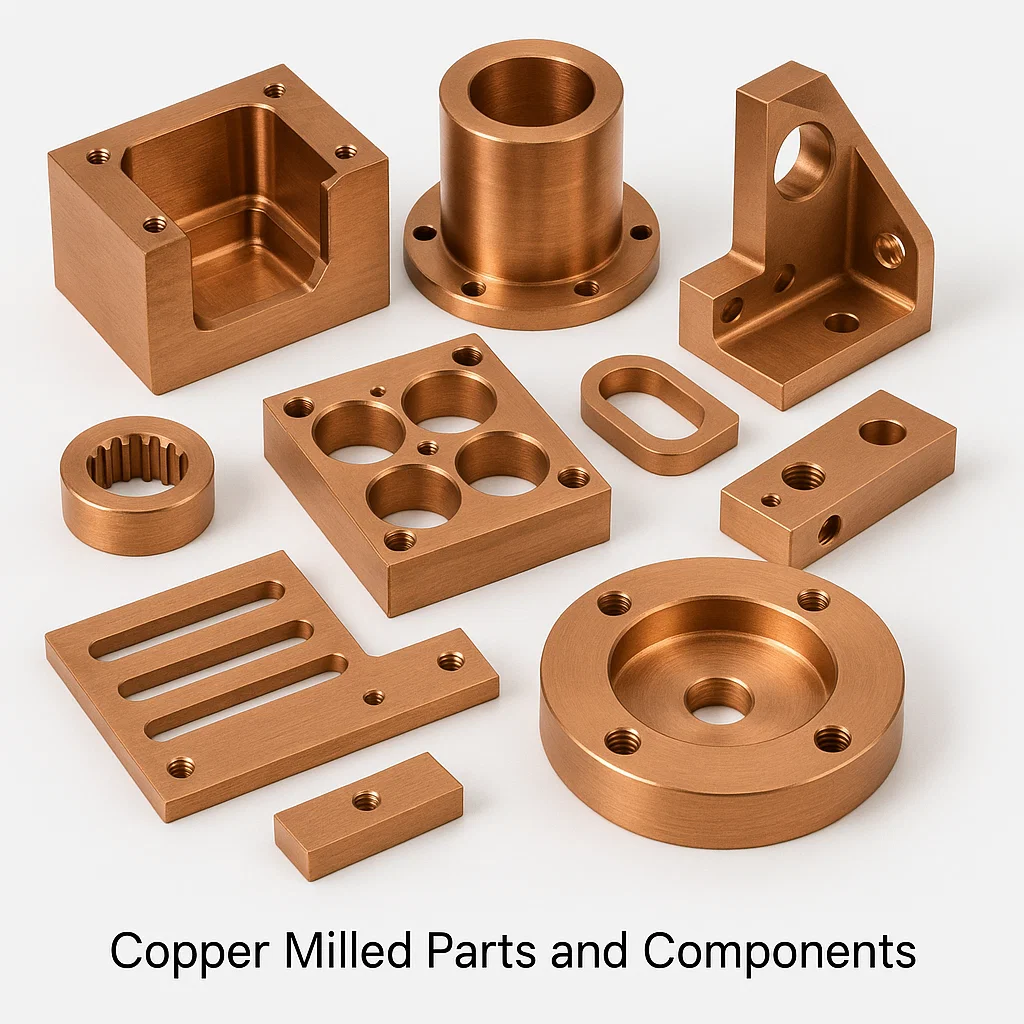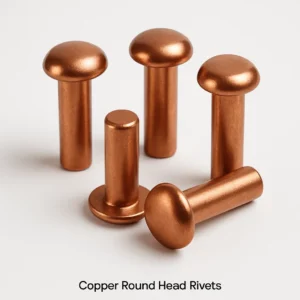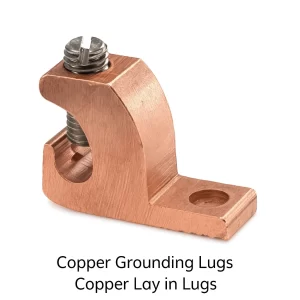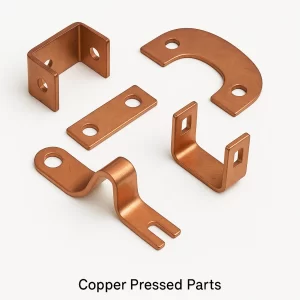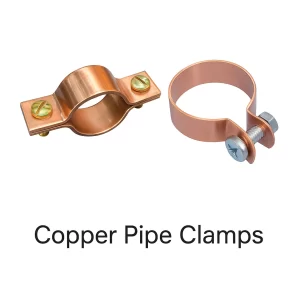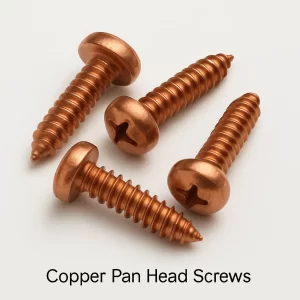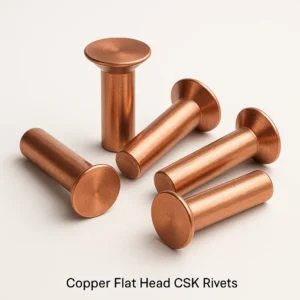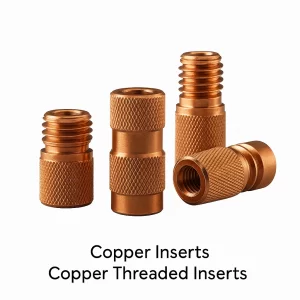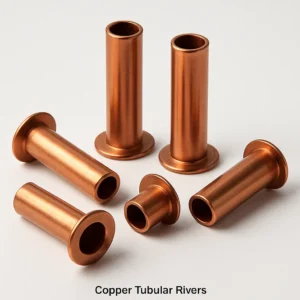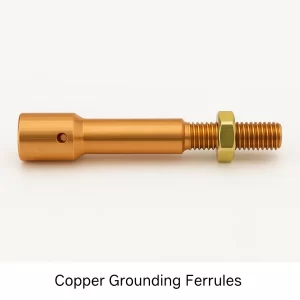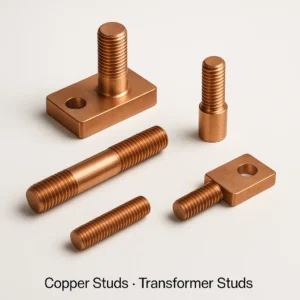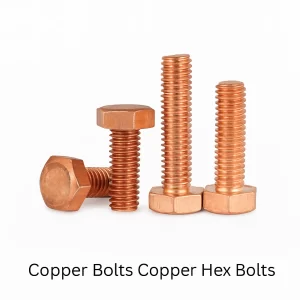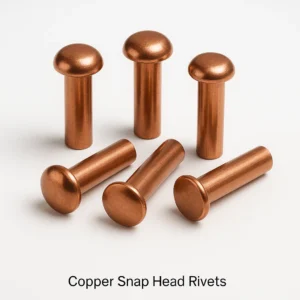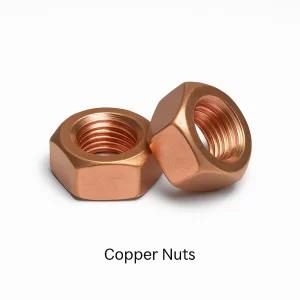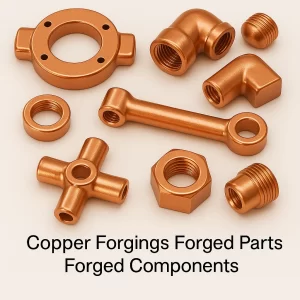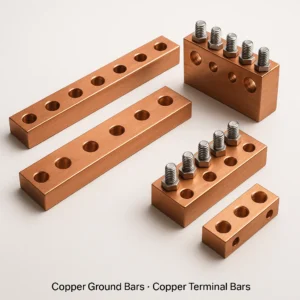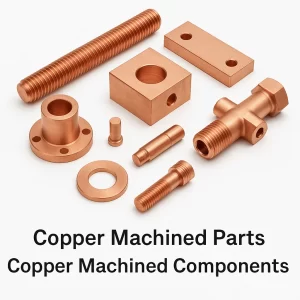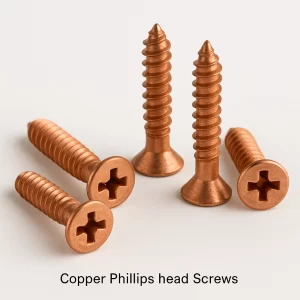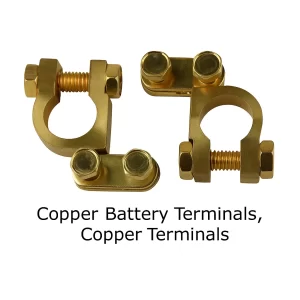Comprehensive Overview of Copper Milled Parts and Copper Milled Components
We are one of the leading manufacturers and exporters of Copper Milled Parts and Copper Milled Components from India. We have been supplying precision copper CNC milled parts, custom copper milled components, copper plate machining, and copper block machining to the world market for many decades. Our state-of-the-art manufacturing facility specializes in producing high-quality copper milled parts using advanced three-axis CNC milling centers, four-axis CNC machining with rotary indexing, five-axis simultaneous milling technology, horizontal machining centers with pallet changers, vertical machining centers with high-speed spindles, and comprehensive post-milling operations. With over three decades of global experience in copper precision milling, we serve diverse industries including electrical copper milled bus bars and distribution components, heat sink copper milled parts for thermal management, waveguide copper milled components for telecommunications, marine copper milled hardware and fittings, industrial copper milled valve bodies and manifolds, aerospace copper milled structural components, medical device copper milled housings and brackets, architectural copper milled panels and hardware, and electronic copper milled enclosures and shielding components. Our expertise encompasses working with various copper grades including pure Copper C11000 milled parts offering excellent electrical and thermal conductivity, Copper C10200 oxygen-free milled components for high-performance applications, Silicon Bronze C65500 milled parts for marine environments, Aluminum Bronze milled components for high-strength requirements, Phosphor Bronze milled parts for wear resistance, Brass milled components for decorative and functional applications, and Beryllium Copper milled parts for specialized high-strength aerospace applications. We manufacture copper milled parts ranging from small precision components with dimensions as small as 10mm to large milled parts exceeding 800mm in length, all maintaining tight tolerances, superior surface finish, excellent dimensional accuracy, and complex geometries achievable only through CNC milling.
Our advanced manufacturing capabilities in producing precision copper CNC milled components extend across multiple milling operations including face milling for flat surfaces and large area material removal, end milling for slots, pockets, and contoured surfaces, profile milling for complex outlines and 3D shapes, pocket milling with optimized tool paths for efficient material removal, contouring operations for complex curved surfaces, engraving for part identification and decorative features, drilling operations for through holes and blind holes in various orientations, tapping for threaded holes, boring for precision hole diameter and straightness, and chamfering for edge finishing and deburring. Our engineering team possesses deep technical knowledge of copper material properties during milling operations, optimal cutting parameters for various copper alloys, carbide and PCD tool selection for copper milling, high-speed machining strategies, climb milling versus conventional milling considerations, coolant selection and application methods, work holding fixture design for copper components, thermal management during machining preventing distortion, and tolerance stack-up analysis ensuring every copper milled part meets or exceeds customer specifications and industry standards. Our quality management system complies with ISO 9001:2015 standards, AS9100 aerospace quality requirements for critical applications, IATF 16949 automotive quality specifications, customer-specific milling requirements, and industry standards for electrical, telecommunications, medical device, and architectural applications. We maintain complete traceability of copper raw material certificates, detailed milling process documentation, dimensional inspection records using coordinate measuring machines with three-dimensional verification, surface finish verification reports, flatness measurement records, and material test reports for every batch of copper milled parts produced. Our customers across North America, European Union countries, United Kingdom, Australia, Middle East regions, and Southeast Asian markets trust our copper milling expertise for their critical precision component applications requiring complex geometries and tight tolerances.
Copper Milled Parts – CNC Milling Operations for Complex Geometries
Copper Milled Parts represent precision components manufactured from copper and copper alloys through CNC milling processes where rotating cutting tools remove material to create flat surfaces, slots, pockets, holes, contours, and complex three-dimensional geometries not achievable through turning operations alone. These copper milled parts are produced using advanced CNC milling centers with computer-controlled movement in multiple axes enabling creation of intricate shapes, precise dimensional accuracy, excellent surface finishes, and repeatable production quality. Copper milled parts find extensive applications in electrical industry including CNC milled copper bus bars with complex mounting provisions and connection points, electrical distribution blocks with multiple holes and threaded connections, switch housing components requiring precise dimensions and flatness, transformer mounting plates and brackets, grounding plates with intricate patterns, and electrical connector bodies with complex internal features, heat management applications including precision milled copper heat sinks with optimized fin arrays for electronic cooling, cold plates with internal fluid passages for liquid cooling systems, heat spreaders for high-power electronics, thermal interface plates requiring flatness specifications, and heat exchanger components utilizing copper thermal conductivity, telecommunications equipment including waveguide components with precise internal dimensions and smooth surfaces for RF signal transmission, antenna mounting hardware with complex geometries, equipment enclosures providing EMI shielding, grounding plates and brackets, and RF connector housings, marine applications including milled valve bodies with internal passages and port configurations, pump housings and covers, flange assemblies, marine hardware components, and saltwater-resistant fittings, aerospace applications including structural brackets and mounting plates utilizing copper alloys for specific properties, electrical bus bar assemblies for aircraft power distribution, waveguide components for avionics, and specialized fastener components, medical device applications including equipment housings requiring precise dimensions and smooth surfaces, mounting brackets and frames, electrical shielding enclosures, and sterilizable component interfaces, architectural applications including decorative copper panels with machined patterns, hardware components for doors and railings, cladding fasteners, and ornamental milled features, and industrial applications including manifold blocks with intersecting passages, valve bodies and bonnets, custom flanges and adapters, and specialized equipment components.
Our copper milling services include engineering consultation for milling process optimization and design for manufacturability, material selection guidance based on mechanical properties, electrical conductivity, thermal conductivity, and corrosion resistance requirements, CAD model review and optimization identifying potential milling challenges, CAM programming using advanced software generating efficient tool paths, fixture design and fabrication for secure work holding preventing deflection and vibration, prototype development with initial milling trials validating process, production milling with consistent quality across batches utilizing statistical process control, various milling operations including three-axis for simple geometries, four-axis with rotary indexing for features in multiple orientations, and five-axis simultaneous for complex contoured surfaces, tolerance capabilities from general ±0.1mm to precision ±0.025mm depending on feature size and complexity, surface finish options from standard milled 3.2 Ra to precision 0.8 Ra through appropriate tooling and parameters, flatness specifications achieving 0.02mm per 100mm for critical surfaces, perpendicularity and parallelism control within 0.03mm for mounting surfaces, secondary operations including deburring, edge radiusing, polishing for improved appearance, and complete documentation with material certificates and comprehensive dimensional inspection reports. We accommodate copper milled part sizes ranging from small components with dimensions as small as 10mm x 10mm x 5mm to large components exceeding 800mm x 600mm x 200mm, weights from a few grams to 50 kilograms, and complexity from simple flat plates with holes to intricate three-dimensional components with internal features and contoured surfaces. Material specifications conform to ASTM B124 for copper bars and rods, ASTM B152 for copper sheet strip plate and rolled bar, ASTM B187 for copper wire rod, ASTM B150 for aluminum bronze, ASTM B98 for silicon bronze, and corresponding international standards including EN designations for European copper grades, JIS specifications for Japanese copper standards, and IS standards for Indian copper materials. The lead time for copper milled parts production typically ranges from four to six weeks depending on component complexity, quantity, material availability, number of milling operations required, fixture requirements, and secondary operations specifications.
Copper Milled Components – Multi-Axis CNC Milling for Complex Features
Copper Milled Components represent advanced precision parts requiring multi-axis CNC milling operations to achieve complex geometries, features in multiple orientations, contoured surfaces, and intricate details not possible with three-axis milling alone. These precision copper milled components are produced using sophisticated four-axis and five-axis CNC machining centers enabling continuous tool access to part surfaces, elimination of multiple setups reducing dimensional stack-up errors, improved surface finish on complex contours through optimal tool orientation, reduced cycle times for complex parts, and capability to machine undercut features. Common multi-axis copper milled components include waveguide assemblies with precise internal contours and transition sections requiring five-axis milling for smooth surfaces critical to RF performance, complex heat sink designs with curved fin arrays and optimized airflow channels machined in single setup, impellers and pump components with twisted vanes and complex blade geometries requiring continuous five-axis tool paths, aerospace structural brackets with complex mounting provisions and weight-reduction pockets accessible from multiple angles, sculptured architectural components with organic shapes and decorative features, medical device housings with ergonomic contours and internal mounting provisions, custom valve bodies with angled ports and intersecting passages, instrumentation housings with complex cable entry provisions and mounting features, and specialized research equipment components with unique geometries designed for specific experimental applications.
The manufacturing process for precision multi-axis copper milled components begins with three-dimensional CAD model analysis and surface verification ensuring model integrity, design for multi-axis manufacturing review identifying optimal machining orientation and axis configurations, advanced CAM programming using simultaneous five-axis tool path generation with continuous tool orientation optimization, simulation and verification preventing collisions between tool, holder, and part or fixture, work holding fixture design providing access to all required surfaces while maintaining rigidity, material procurement of specified copper grade with dimensional verification, first operation milling with in-process inspection of critical features, second operation milling if required with precise part location transfer, finish milling using appropriate stepover and speeds for required surface finish, deburring and edge finishing removing sharp edges and burrs from complex geometries, dimensional inspection using coordinate measuring machines with three-dimensional probing validating all features, surface finish verification on critical surfaces, flatness and perpendicularity measurement for mounting surfaces, and documentation preparation with comprehensive inspection reports. Our multi-axis copper milling capabilities include four-axis simultaneous machining with continuous rotation enabling cylindrical features, angular drilling, and helical milling, five-axis positioning with rotary-tilt table or swivel head configuration enabling features in multiple orientations, five-axis simultaneous contouring for complex curved surfaces with optimal tool orientation throughout cut, indexed five-axis for features requiring angular access without continuous motion, and hybrid approaches combining three-axis, four-axis, and five-axis operations for optimal cycle times.
Copper Material Grades and Milling Specifications
Copper Material Specifications and Standards for Milled Parts
| Copper Grade | International Designation | Key Properties | Typical Milled Applications | Standards |
|---|---|---|---|---|
| Copper C11000 | CW004A (EN), C1100 (JIS), T2 (GB) | 99.9% pure copper, 100% IACS conductivity, thermal conductivity 391 W/m·K | Bus bars, heat sinks, electrical plates, thermal components | ASTM B124, BS EN 1652, DIN EN 13601, JIS H3250, IS 191 |
| Copper C10200 | CW008A (EN), C1020 (JIS), TU2 (GB) | Oxygen-free copper, 101% IACS conductivity, vacuum tight | Waveguides, vacuum equipment, high-performance electrical | ASTM B170, BS EN 1652, DIN EN 13599, JIS H3250 |
| Silicon Bronze C65500 | CW115C (EN), CAC406 (JIS) | High strength 380-520 MPa, excellent machinability 80% | Marine hardware, valve bodies, pump components, fittings | ASTM B98, BS EN 12163, JIS H3250 |
| Aluminum Bronze C95400 | CW307G (EN), CAC703 (JIS) | Very high strength 620-750 MPa, wear resistant | Heavy-duty marine, valve bodies, pump impellers | ASTM B150, BS EN 1982, JIS H5120 |
| Phosphor Bronze C51000 | CW450K (EN), C5191 (JIS) | Wear resistant, spring properties, corrosion resistant | Bearings, bushings, wear plates, electrical contacts | ASTM B103, BS EN 12166, JIS H3110 |
| Brass C36000 | CW614N (EN), C3604 (JIS) | Free-machining brass, excellent machinability 90% | Decorative panels, hardware, architectural components | ASTM B16, BS EN 12164, JIS H3250 |
| Beryllium Copper C17200 | CW101C (EN), C1720 (JIS) | Highest strength 1170-1310 MPa heat treated, non-magnetic | Aerospace components, high-strength electrical, specialized | ASTM B194, BS EN 12166, JIS H3270 |
Copper Milling Parameters and Capabilities
| Parameter | 3-Axis Milling | 4-Axis Milling | 5-Axis Milling |
|---|---|---|---|
| Tolerance Capability | ±0.05mm to ±0.1mm | ±0.03mm to ±0.08mm | ±0.025mm to ±0.05mm |
| Surface Finish | 1.6-6.3 Ra | 1.6-3.2 Ra | 0.8-3.2 Ra |
| Maximum Dimensions | 800 x 600 x 200mm | 600 x 500 x 400mm | 500 x 500 x 400mm |
| Spindle Speed | 8000-15000 RPM | 8000-20000 RPM | 12000-24000 RPM |
| Typical Cutting Speed | 100-300 m/min | 150-350 m/min | 200-400 m/min |
| Tool Material | Carbide, HSS | Carbide, PCD | Carbide, PCD |
Manufacturing Processes and CNC Milling Technology
Our precision copper CNC milling facility employs comprehensive manufacturing processes including three-axis vertical machining centers with table sizes up to 800mm x 600mm for general copper component milling, high-speed vertical machining centers with spindle speeds up to 15000 RPM for fine feature milling and excellent surface finish, four-axis horizontal machining centers with rotary table enabling features in multiple orientations without repositioning, four-axis vertical machining centers with tilting rotary table for angular features, five-axis simultaneous machining centers with swivel head or trunnion table for complex contoured surfaces, horizontal machining centers with automatic pallet changers for high-volume production with reduced setup time, gantry-type machining centers for large copper plate and block machining, high-speed milling with spindle speeds up to 24000 RPM for copper finishing operations, adaptive clearing strategies with dynamic tool engagement for efficient roughing, and trochoidal milling for slots and pockets reducing tool deflection.
Manufacturing Process Flow: Copper raw material procurement with certified test reports → Material inspection and dimensional verification → CAD model analysis and CAM programming → Tool selection and preparation → Fixture setup and work holding → First article milling and inspection → Production milling with in-process monitoring → Deburring and edge finishing → Secondary operations if required → Final inspection using CMM → Documentation preparation → Protective packaging → Shipment.
Copper Milling Best Practices: Use sharp carbide or PCD cutting tools preventing work hardening and built-up edge, employ high cutting speeds 200-400 m/min with moderate feeds for copper alloys, utilize climb milling for better surface finish and longer tool life, implement adequate coolant flow for chip evacuation and thermal management, maintain rigid setup with appropriate fixtures minimizing vibration, use trochoidal or high-efficiency milling strategies for deep pockets, apply step-down and stepover appropriate for part geometry and surface finish requirements, program tool paths avoiding sudden direction changes causing tool marks, and control cutting forces preventing copper work hardening and dimensional distortion.
Typical Copper Milled Components and Applications
Electrical Bus Bar Assemblies: CNC milled copper bus bars with complex shapes and mounting holes, multi-layer bus bar stacks requiring precise hole alignment and flatness specifications, electrical distribution blocks with multiple connection points and threaded holes, switchgear bus bar assemblies with intricate geometries, transformer connection plates with precise mounting provisions, and high-current bus bar systems utilizing copper conductivity.
Heat Sink Components: Precision milled copper heat sinks with optimized fin arrays for forced-air or natural convection cooling, cold plates with internal fluid passages for liquid cooling applications, heat spreaders with varying thickness for thermal management, skived fin heat sinks with thin closely-spaced fins, pin fin heat sinks with cylindrical or rectangular pin arrays, and embedded heat pipe heat sinks combining milled copper with heat pipes.
Waveguide Components: Rectangular waveguide sections with precise internal dimensions for RF signal transmission, circular waveguide components, waveguide transitions and adapters, waveguide filters with internal resonant cavities, antenna feed systems, and microwave components requiring smooth internal surfaces and dimensional accuracy.
Marine Valve Bodies: Silicon Bronze or Aluminum Bronze milled valve bodies with internal passages and port configurations, valve bonnets and covers with sealing surfaces, flange assemblies for pipe connections, pump housings with volute passages, and marine fittings requiring corrosion resistance.
Aerospace Structural Components: Milled aluminum bronze or beryllium copper brackets with weight-reduction pockets, mounting plates with complex hole patterns, structural fittings, electrical bus bar assemblies for aircraft power distribution, and specialized fastener components.
Medical Device Housings: Milled copper alloy equipment housings with precise mounting provisions, EMI shielding enclosures utilizing copper conductivity, surgical instrument components requiring smooth surfaces and dimensional accuracy, and diagnostic equipment brackets and frames.
Architectural Hardware: Decorative milled copper panels with machined patterns and textures, door hardware components, handrail fittings and brackets, copper cladding fasteners with aesthetic features, and ornamental architectural elements combining functional and decorative milling.
Industrial Manifolds: Hydraulic manifold blocks with intersecting passages drilled and milled from copper alloy bar stock, pneumatic manifolds for automation, fluid distribution blocks, and custom manifold assemblies for specialized industrial equipment.
Milling Tolerances and Quality Standards
Standard Milling Tolerances for Copper Parts
| Feature Type | Standard Tolerance | Precision Tolerance | Ultra-Precision Tolerance |
|---|---|---|---|
| Linear Dimensions | ±0.1mm | ±0.05mm | ±0.025mm |
| Hole Positions | ±0.08mm | ±0.04mm | ±0.02mm |
| Pocket Dimensions | ±0.15mm | ±0.08mm | ±0.04mm |
| Flatness | 0.05mm/100mm | 0.02mm/100mm | 0.01mm/100mm |
| Perpendicularity | 0.05mm/50mm | 0.03mm/50mm | 0.02mm/50mm |
| Parallelism | 0.05mm/100mm | 0.03mm/100mm | 0.02mm/100mm |
| Surface Finish Face Milling | 3.2-6.3 Ra | 1.6-3.2 Ra | 0.8-1.6 Ra |
| Surface Finish Contouring | 1.6-3.2 Ra | 0.8-1.6 Ra | 0.4-0.8 Ra |
| Hole Diameter | ±0.05mm | ±0.025mm | ±0.015mm |
Quality Control and Inspection
Dimensional Inspection: Every batch of copper milled parts undergoes comprehensive dimensional inspection using coordinate measuring machines with three-dimensional probing capability and accuracy ±0.002mm verifying all critical dimensions, optical comparators for profile verification and edge definition, precision calipers and micrometers for basic dimensions, depth micrometers for pocket and slot depths, pin gauges for hole diameters, granite surface plates with dial indicators for flatness measurement, and custom inspection fixtures for complex geometries requiring specific datum references.
Surface Quality Verification: Surface finish testing using contact or optical profilometers measuring Ra, Rz, and other surface parameters, visual inspection under magnification for surface defects including tool marks, chatter marks, or material imperfections, edge quality assessment verifying absence of burrs and proper edge breaks, and functional surface testing for sealing surfaces or electrical contact surfaces requiring specific finish.
Geometric Dimensioning and Tolerancing (GD&T): Verification of geometric tolerances including flatness, perpendicularity, parallelism, concentricity, and position tolerances per ASME Y14.5 or ISO 1101 standards, datum establishment and inspection methodology, feature control frame interpretation, and documentation demonstrating conformance.
Material Verification: Chemical composition analysis using optical emission spectroscopy confirming copper grade matches material certification, hardness testing validating material condition, electrical conductivity testing for applications requiring specific conductivity values, and material certificates from copper supplier documenting chemical analysis and mechanical properties.
First Article Inspection: Complete dimensional verification of initial production piece with all features measured including hole positions, pocket dimensions, surface flatness, and geometric tolerances, comparison to engineering drawing specifications identifying any deviations, process capability assessment, customer approval before production run commences, and comprehensive first article inspection report with actual measurements.
Documentation: Material certificates with chemical analysis and mechanical properties, dimensional inspection reports with actual measurements and tolerances, first article inspection reports for new part numbers, surface finish test results, flatness measurement records, certificate of conformance stating compliance with specifications, and traceability documentation linking production batches to inspection records.
Industries and Applications
Electrical Power Industry: Milled copper bus bars for switchgear and distribution panels, electrical distribution blocks for power systems, transformer mounting plates and connection hardware, circuit breaker components, grounding plates and bus bars, and electrical components utilizing copper conductivity.
Electronics and Thermal Management: Precision milled heat sinks for CPU and GPU cooling, cold plates for liquid cooling systems, heat spreaders for high-power electronics, thermal interface plates, electronics enclosures with EMI shielding, and thermal management components utilizing copper thermal conductivity.
Telecommunications Industry: Waveguide components for RF signal transmission, antenna mounting hardware and brackets, telecommunications equipment enclosures, grounding plates for tower installations, RF connector housings, and microwave components requiring dimensional precision.
Marine Industry: Silicon Bronze and Aluminum Bronze valve bodies for seawater service, pump housings and components, marine hardware and fittings, propeller components, ship fittings and hardware, and saltwater-resistant milled components.
Aerospace Industry: Structural brackets and mounting plates, electrical bus bar assemblies for aircraft, waveguide components for avionics, specialized fastener components, and beryllium copper components for high-strength non-magnetic applications.
Medical Devices: Equipment housing components, EMI shielding enclosures for sensitive electronics, mounting brackets and frames, surgical instrument components, diagnostic equipment parts, and medical device interfaces requiring precision and cleanliness.
Architectural Applications: Decorative milled copper panels for facades and interiors, door hardware and fittings, handrail brackets and components, copper cladding fasteners, and ornamental architectural elements.
Industrial Machinery: Hydraulic manifold blocks with intersecting passages, valve bodies and components, custom flanges and adapters, pump housings, process equipment parts, and specialized industrial components.
Performance Specifications
Copper Milled Parts Performance Parameters
| Parameter | Pure Copper | Silicon Bronze | Aluminum Bronze | Beryllium Copper |
|---|---|---|---|---|
| Tensile Strength | 220-260 MPa | 380-520 MPa | 620-750 MPa | 1170-1310 MPa |
| Milling Machinability | Fair (30-40%) | Excellent (80-90%) | Fair (30-40%) | Good (50-60%) |
| Electrical Conductivity | 100% IACS | 7% IACS | 12% IACS | 22% IACS |
| Thermal Conductivity | 391 W/m·K | 42 W/m·K | 71 W/m·K | 105 W/m·K |
| Achievable Tolerance | ±0.025mm | ±0.025mm | ±0.03mm | ±0.025mm |
| Best Surface Finish | 0.8 Ra | 0.4 Ra | 1.6 Ra | 0.8 Ra |
| Flatness Capability | 0.01mm/100mm | 0.01mm/100mm | 0.02mm/100mm | 0.01mm/100mm |
Frequently Asked Questions
Q1: What are the advantages of CNC milling for copper components?
CNC milling enables complex geometries not achievable through turning including pockets, slots, contours, and features in multiple planes, excellent flatness and surface finish critical for electrical contact and thermal interface applications, precise hole positioning for mounting and assembly, ability to machine large flat plates and blocks, capability for multi-sided machining in single setup reducing tolerance stack-up, and flexibility for prototype and production quantities.
Q2: Can you mill thin copper plates without distortion?
Yes, we mill thin copper plates using specialized techniques including vacuum work holding distributing clamping force uniformly, adaptive machining strategies minimizing cutting forces, climb milling reducing tool pressure on part, multiple light passes rather than heavy cuts, stress-relieving pre-machining if required, temperature monitoring and thermal management, and fixture design supporting thin sections. Typical minimum thickness 2-3mm depending on plate area and feature complexity.
Q3: What is the typical lead time for copper milled parts?
Standard lead time is four to six weeks from purchase order confirmation to shipment, accounting for engineering review and CAM programming, copper material procurement with certified test reports, fixture design and fabrication for new parts, first article milling and inspection approval, production milling operations, secondary operations if required, quality inspection using CMM, and protective packaging. Repeat orders using existing programs and fixtures have shorter lead times of 2-3 weeks depending on complexity and quantity.
Q4: What surface finishes are achievable with copper milling?
Surface finishes achievable depend on milling operation and parameters: face milling typically 3.2-6.3 Ra standard, 1.6-3.2 Ra with fine finish parameters, end milling and contouring 1.6-3.2 Ra standard, 0.8-1.6 Ra with ball end mills and appropriate stepover, and 0.4-0.8 Ra achievable through high-speed finishing with PCD tools. Further improvement possible through post-milling operations including fly cutting, grinding, or polishing for applications requiring mirror finishes.
Q5: What documentation is provided with copper milled parts shipments?
We provide comprehensive documentation including material certificates from copper supplier with chemical analysis and mechanical properties, dimensional inspection reports showing actual measured values for all critical features, first article inspection reports for new part numbers with complete dimensional verification per customer drawing, surface finish test results where specified, flatness measurement records for critical surfaces, certificate of conformance stating compliance with purchase order specifications, and traceability documentation linking production batches to material heat numbers and inspection records.
Why Choose Our Copper Milling Services
Three Decades of Precision Milling Excellence: With over 30 years of copper CNC milling experience serving electrical, electronics, telecommunications, marine, aerospace, and industrial industries across global markets, we have developed deep expertise in copper material behavior during milling, optimal cutting strategies, fixture design, and quality assurance.
Advanced Multi-Axis Machining Capabilities: Our facility houses three-axis, four-axis, and five-axis CNC machining centers enabling complex copper component production, horizontal machining centers with pallet changers for high-volume efficiency, high-speed machining centers with spindle speeds to 24000 RPM for finishing operations, and large-format machining centers accommodating parts up to 800mm x 600mm.
Comprehensive Copper Grade Expertise: We mill components from pure copper C11000 for electrical and thermal applications, oxygen-free copper C10200 for waveguides and vacuum equipment, Silicon Bronze for marine environments and excellent machinability, Aluminum Bronze for high-strength marine applications, Phosphor Bronze for wear resistance, various Brass alloys, and Beryllium Copper for aerospace requirements.
Superior Quality Control: Every batch undergoes dimensional inspection using coordinate measuring machines with ±0.002mm accuracy and three-dimensional verification, flatness measurement on granite surface plates, surface finish testing with contact profilometers, material verification through chemical analysis, first article inspection with comprehensive documentation, and final inspection ensuring all specifications are met.
Engineering Support and Design Optimization: Our experienced engineering team provides design for manufacturability consultation optimizing geometries for milling, CAD model analysis and surface verification, fixture design for rigid work holding, CAM programming optimization for efficient tool paths, tolerance analysis and stack-up studies, multi-axis machining strategy development, and technical support throughout production.
Competitive Manufacturing Advantage: Manufacturing in India provides significant cost advantages allowing us to offer copper CNC milling services typically 30-40% lower cost than North American or European manufacturers without compromising quality standards, dimensional accuracy, surface finish quality, or material specifications.
International Standards Compliance: Our copper milled parts conform to international standards including ASTM material specifications, ISO geometric tolerancing per ISO 1101, ASME Y14.5 GD&T standards, customer engineering drawings and specifications, and industry-specific requirements for electrical, telecommunications, medical device, aerospace, and architectural applications.
Flexibility and Scalability: We accommodate both prototype quantities with rapid CAM programming and setup for design validation and high-volume production using optimized processes and fixtures, offering flexible minimum order quantities, scalable production capacity across multiple machining centers, and consistent quality from prototypes through production.
Glossary of Technical Terms
CNC Milling: Computer Numerical Control milling using rotating cutting tools removing material to create shapes and features.
Three-Axis Milling: CNC milling with movement in X, Y, and Z linear axes.
Four-Axis Milling: CNC milling adding rotary axis enabling features in multiple orientations.
Five-Axis Milling: CNC milling with three linear and two rotary axes enabling complex contoured surfaces.
Climb Milling: Milling method where cutter rotation direction matches feed direction, producing better finish.
Trochoidal Milling: High-efficiency strategy using circular tool motion for slots and pockets.
Adaptive Clearing: Milling strategy maintaining constant tool engagement and cutting forces.
Face Milling: Milling flat surfaces using cutter with cutting edges on periphery and face.
End Milling: Milling using cylindrical cutter for slots, pockets, and contours.
Ball End Milling: Milling using spherical end cutter for contoured surfaces.
Ra (Roughness Average): Surface finish measurement expressing average profile deviation.
Flatness: Geometric tolerance specifying allowed deviation from perfect plane.
GD&T: Geometric Dimensioning and Tolerancing system defining part geometry and tolerances.
Call to Action – Contact Us Today
Ready to discuss your copper milling requirements? Our experienced team is here to help you with precision copper CNC milled parts and components for your critical applications.
Request a Quote: Send us your technical drawings, 3D CAD models, and quantity requirements to sales@jambrass.com for a detailed quotation within 24 hours.
Call Us Directly: Speak with our technical sales team at +91-22-43449300 / +91-22-43449323 during business hours (Monday-Saturday, 9:00 AM – 6:00 PM IST) to discuss your copper milling requirements.
Visit Our Offices:
Office Address: 1406, 14th Floor, Dalamal Tower, Nariman Point, Mumbai – 400021, Maharashtra, India
Factory Address: Plot 10B, GIDC Industrial Estate, Shanker Tekari, Udyognagar, Jamnagar, Gujarat, India – 361004
Contact Person: Mr. Mehul Vora
Quality Documentation: Request sample certificates of conformance, material test reports, dimensional inspection records, and milling capability documentation by contacting sales@jambrass.com

